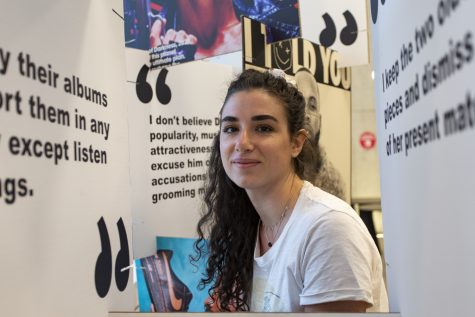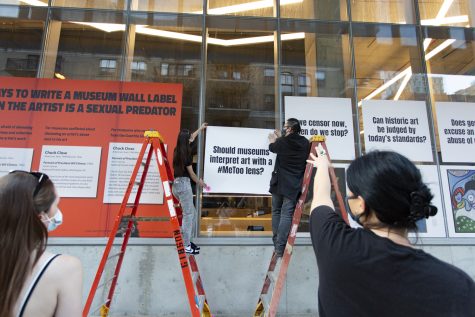New gallery asks viewers, ‘Does the Art Excuse the Accused?’
April 15, 2021

Should an artist’s abusive or harmful actions be excused for the sake of viewers’ enjoyment of their work, and can this information enable people to draw more meaning from the art? These are some of the questions Madison Pope raises in the “Does the Art Excuse the Accused?” exhibition.
In the #MeToo era, artists have been forced to become more accountable for their actions. Pope, the exhibition’s curator and a 2020 art history alum, said the exhibition is not intended to tell people how to think, but rather to have viewers reflect on the artists they idolize.
“Everyone knows Picasso,” Pope said. “He’s been upheld as this genius, … but people are taking a second look at him because he paints a lot of portraits of the women that he was with. He was a well-known womanizer in the art world. … Should we really be holding up these people on a pedestal like this and promoting that kind of lifestyle?”
The exhibition, hosted by the Hokin Gallery and managed by students in the “Gallery Management: Practicum” course, is located on the first floor of the Student Center, 754 S. Wabash Ave., and poses questions for viewers to ask themselves about artists and their work. It also highlights artwork from feminist artists Michelle Hartney, the Guerrilla Girls and Tatyana Fazlalizadeh.

Inside the building, large square cardboard posters show the face, album cover, movie poster or artwork of an accused artist on the front.
The back of the posters show responses from crowdsourced faculty, students or Hokin Gallery social media followers who anonymously answered why they have reconsidered the artist’s work. Each poster has one line taken from the person’s response.
Pope said the idea for the exhibit emerged in Spring 2019 when she took the “Exhibition Management” course, taught by Bob Blandford, an associate professor in the Business and Entrepreneurship Department.
Pope said her final project was to pitch three exhibition ideas that could come to fruition conceptually. During class, she said someone mentioned Michael Jackson and his music in conversation. This sparked a heated discussion because of the child sexual abuse allegations against Jackson, she said.
“We were left with even more questions than we had started [with] because there’s such a gray area when you’re trying to figure out if you should really separate the art from the artist, which is really what this exhibit is all about,” Pope said.

She and her classmates were able to flush out the idea for the current exhibit as she continued her studies in art history during the “Gallery Management: Practicum” and the “Curatorial Practicum” courses.
Pope’s classmate and 2020 photography alum Madeline Cox helped research various artists to feature in the exhibition. She said one of the challenges of finding artists was shifting through legitimate allegations and “gossip rumors” while listening to potential victims.
The cardboard posters feature artists ranging from musicians like R. Kelly and Børns, to actors like Kevin Spacey and Danny Masterson, and authors such as J. K. Rowling and F. Scott Fitzgerald.
“We didn’t want to slander anyone,” Cox said. “If things were alleged, we made sure we said, ‘This is alleged. He or she may have done this.’ … We’re not trying to spread rumors, but these are things that people have said or come forward [with].”
The exhibit opened April 8 during national Sexual Assault Awareness Month, and exhibitors are partnering with Columbia’s Sexual Assault Awareness Education Committee, which promotes programs and supports services on- and off-campus. It provides services such as assistance in reporting Title IX cases, discussion workshops and confidential resources.
Öykü Kolat, a senior art history major and exhibition developer, said she helped create the questions for the survey that garnered anonymous responses from people about various artists.

When brainstorming, Kolat said she and her group of fellow classmates were intentional in avoiding leading questions. The people who were surveyed contributed to the ongoing narrative of the exhibit, with some completely changing their mindset after learning about the actions of an artist, while others remained unchanged in their views, she said.
The team also received responses about how people view the time period in which the artist’s actions happened and whether or not a director being “canceled” should mean the entire cast and crew who also worked on the show or film should be canceled.
“Because of social media and [the] #MeToo movement bringing new personal histories, we can rethink how we interact with the works, but also it is important that we always emphasize … we don’t condone any sides, and … it’s however you want to interpret the art,” Kolat said.
“Does the Art Excuse the Accused?” runs through May 16. You can fill out this survey to be a part of the exhibit. Answers will be incorporated into the ongoing installation.







